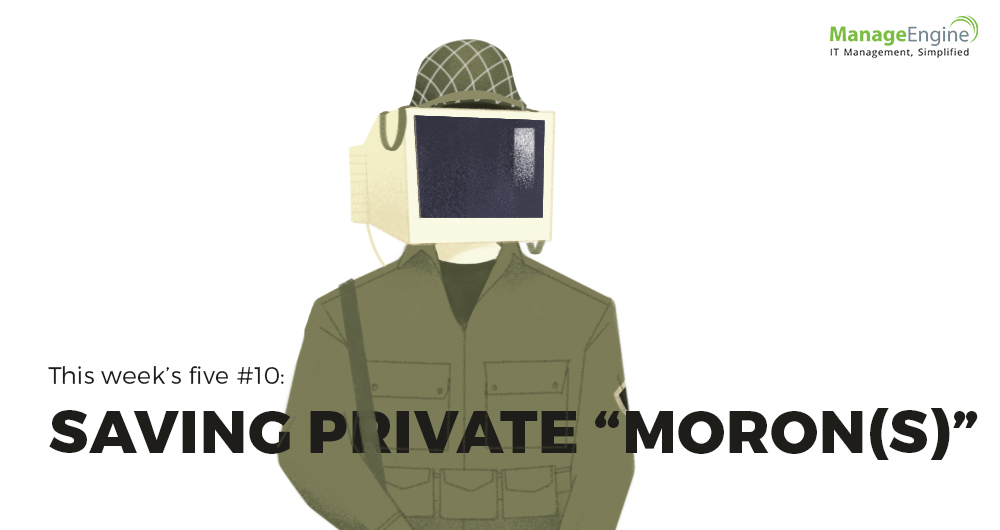This week’s five: Saving private “moron(s)”
This week’s five is a weekly column on five recent reads from all over the web. This week, we’ll talk about IT security.
"The computer is a moron."
- Peter F. Drucker
An eminent thinker, Drucker's intention wasn't to undermine the amazing capabilities of computers. He merely underlined the fact that computers don't make their own decisions—they just follow orders, regardless of who's giving them. As long as the command syntax is correct, computers do what they are told. And unfortunately, all our advances, including those in IT, depend on these digital morons. No wonder IT is never safe.
"There are only two types of companies: Those that have been hacked, and those that will be."
- Robert S. Mueller, Former director, Federal Bureau of Investigation
Despite knowing how real the threat is, companies don't implement the right solutions. Perhaps they live in a reality distortion field, meaning they hold an unshakable belief that wanting and willing something, even if it's near impossible, can make it happen. They don't fully understand the data breach situation. Close to five billion records have been lost or stolen since 2013. This means that every second, 41 records are lost. So, it's a good time to shake the unshakable and instead of spending heavily, start spending smartly on IT security.
[To understand why nothing's completely secure, click here.]
[To learn more about IT security's reality distortion field, click here.]
Let's start with enterprise mobility. It's true that enterprise mobility can raise your productivity to new heights. But using mobile devices can bring many challenges—large scale device monitoring, end-point data security, unregulated BYOD policy, and usage of legacy apps with regular apps, to name a few. So forget about traditional MDM tools. What you need here is an intuitive enterprise mobility solution that, apart from monitoring devices and ensuring policy compliance, can deliver geo-location tracking, sensitive data protection, mobile application management, and BYOD support. Remember, with threats, solutions must evolve too.
[Learn how to untangle major enterprise mobility challenges, right here.]
Collaboration is another productivity booster. But it also leads to a surge in end users and excessive data sharing. And as the user traffic increases, keeping an eye on everything in your network becomes even more challenging. From a simple executable file to an advanced persistent threat (APT), anything can harm your organization. Many of these threats can be effectively handled with processes such as application whitelisting, IT compliance management, event log monitoring, and privileged password management. But some of them, say malwares, can still remain in the network and affect its performance. Therefore, it's essential to analyze data packet flows and track their movement in the network in real time. This is a lot easier with an integrated all-in-one network management solution that can administer faults and firewall logs, analyze bandwidths, scan IP addresses and switch ports and manage configurations.
[To learn how to overcome collaboration challenges, click here.]
But investing only on technologies and software applications is not enough. After all, engines don't run on their own. To run a process effectively, you'll need to hire the right set of people.
"The stupider the tool, the brighter the master has to be—and this is the dumbest tool we have ever had."
- Peter F. Drucker
Blunt yet wise, Drucker again speaks the truth. Needless to say, we need security experts—crazy brilliant security experts. And not having them onboard may actually lead to expensive safeguarding measures. In fact, according to a recent report by Kaspersky, you could end up spending three times more on your IT security cover ups if you don't hire sufficiently skilled experts. Three times! Not so smart, right?
[Demand for IT experts is rising. Check out why right here.]
In the four minutes you spent reading this blog, almost 10,000 records were lost. Better stop reading now and run for your IT—save your morons!
Check out last week's five here.